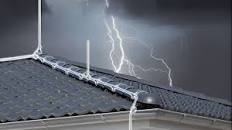Why It's Important and How Surge Protection Devices Work
Lightning strikes can cause significant damage to buildings, equipment, and people. This is why it's crucial to have a lightning protection system in place. In this article, we'll discuss lightning protection and the role of surge protection devices, lightning arresters, and lightning protection levels.
What is Lightning Protection?

Lightning protection is the practice of safeguarding buildings, equipment, and people from the damaging effects of lightning strikes. Lightning protection systems are designed to direct the electrical energy from a lightning strike safely into the ground. A lightning protection system consists of a network of conductors, ground rods, and surge protection devices.
Why Do You Need Lightning Protection?

Lightning strikes can cause significant damage to buildings, electrical systems, and electronic devices. Lightning can create electrical surges that can damage sensitive electronics, cause fires, and even injure or kill people. Lightning strikes are unpredictable, and it's impossible to eliminate the risk of a strike entirely. However, a lightning protection system can help reduce the risk and minimize the damage caused by a strike.
Surge Protection Devices

Surge protection devices are a critical component of a lightning protection system. These devices are designed to protect electrical and electronic equipment from power surges caused by lightning strikes. Surge protection devices work by diverting excess electrical energy safely to the ground.
There are several types of surge protection devices, including plug-in surge protectors, whole-house surge protectors, and industrial surge protectors. Plug-in surge protectors are used to protect individual devices, while whole-house surge protectors are installed at the main electrical panel and provide protection to the entire home. Industrial surge protectors are used to protect large commercial and industrial facilities.
Lightning Arresters

Lightning arresters are also known as surge arresters or surge suppressors. These devices are designed to protect electrical equipment from high-voltage electrical surges caused by lightning strikes. Lightning arresters work by diverting the excess electrical energy from a lightning strike safely to the ground.
There are several types of lightning arresters, including gap-type lightning arresters, valve-type lightning arresters, and metal-oxide varistor (MOV) lightning arresters. Gap-type lightning arresters are the oldest type and work by creating a gap in the electrical circuit that breaks down when a surge occurs, allowing the excess energy to flow safely to the ground. Valve-type lightning arresters use a series of spark gaps and valves to divert the excess energy. MOV lightning arresters use a metal-oxide varistor to absorb the excess energy and divert it safely to the ground.
Lightning Protection Levels

Lightning protection levels are used to determine the level of protection required for a particular building or structure. The lightning protection level is determined based on the height of the structure, the location, and the risk of a lightning strike. There are four lightning protection levels:
Level:
Structures that are essential for public safety, such as hospitals and fire stations.
Level II:
Structures that are essential for public service, such as schools and government buildings.
Level III:
Structures that contain valuable or irreplaceable contents, such as museums and libraries.
Level Iv:
Structures that are not essential but still require protection, such as residential homes.
Conclusion
Lightning protection is essential for any building or structure that is at risk of a lightning strike. Surge protection devices, lightning arresters, and lightning protection levels are all critical components of a lightning protection system. By implementing these measures, you can help reduce the risk of damage to your property and protect your valuable electronic equipment from the damaging effects of lightning strikes.
Appreciate the creator